What’s New in October
Do you want to get a personal email notification of a new Complement issue or new material? Email us at openinforvm@gmail.com and we will put you on the mailing list
Past articles are all on display; If there is a “Load More” link at the bottom of the page, clicking it will bring up the older articles.
EXTRA EXTRA EXTRA
See the Arts & Info section for late-breaking news on the upcoming Craft Fair and Silent Auction !!
Plus, updates and new materials have been added to the Coordinators’ Corner on the Prepare page.
NEWS & VIEWS
Emergency Power at Home: Why, What and How, by Joni Johnson
– An electrifying article! A real turn-on!
Readiness Review Reminder, by Bob Buddemeier
– Do you know what’s in your go-bag? Or where it is?
Bringing Lawn Bowling Back to Its Former Glory, by Joni Johnson
– Maybe if the balls were spherical?
in Big, Borrowed, or Both
3550: the Portland Mirabella quarterly magazine (most recent issue)
Mirabella Monthly, Newsletter of the Seattle Mirabella (Current issue)
ARTS & INFO
Silent Auction, by Joni Johnson NEW
– Spend big, win big!
Virtual Craft Fair, by Connie Kent NEW
– It turns real on Nov 1.
2021 Craft Fair Coming!, by Connie Kent
– Stand by for a mid-month special edition!
RVM September – October Event & Entertainment Schedule
October Library Display, by Anne Newins
– The play’s the thing!
What Goes Around, Comes Around, by Madge Walls
– A novelist’s notes on writing a novel
Book Review: The Phone Booth at the Edge of the World, by Bonnie Tollefson
Nit-Wit Newz, by A. Looney
– Squirrels, booze, and infrastructure
PREPARE
The entire Prepare page is being revised and updated — check back frequently
Pet Preparedness, by Vicki Gorrell
– “Let meowt onto the woof!”
Coordinators Corner — Reports, comments, Q&A, Final document drafts for review and comment
– This month: Report on 10/06 Coordinators meeting (radio training, Safety Vests). Information document drafts for review: Personnel backups; Communication Workshop plan; Preparedness Review and Great Shakeout
What Goes Around, Comes Around
Finishing a Novel during Covid Time
By Madge Walls
 My novels have routinely taken six years to finish. Why? Working fulltime, many other distractions, and sheer laziness. Add in my favorite activity of reading other author’s novels, and you get the picture.
My novels have routinely taken six years to finish. Why? Working fulltime, many other distractions, and sheer laziness. Add in my favorite activity of reading other author’s novels, and you get the picture.
When Covid-19 hit in the spring of 2019 and Rogue Valley Manor closed down all group activities and began delivering all meals to our doors, we had to make peace with being basically shut-ins. How, then, to keep busy?
There in my computer lay my unfinished work, The Visiting Girl, inspired by the early life of movie star Katharine Hepburn’s mother, a suffragist who’d had to fight her guardian/uncle to attend Bryn Mawr College according to her late mother’s will and wishes.
I’d become bored with the novel after working on it for those six years. But when I went back to it, I realized I had unwittingly set the tale in 1900 through 1923 (reflecting the elder Kate’s young life), when my characters’ lives would have been impacted by the Spanish flu pandemic, The Great War, Prohibition, and the women’s suffrage movement.
As I dove deeper into my research, I saw more and more how our life today seems an echo of that era: our own Covid-19 pandemic; the wars of our adulthood—Vietnam, Iraq, Afghanistan; efforts to prohibit mask and vaccine mandates; and women’s rights that we are still fighting for. I was blown away by the similarities—do we never learn anything?
Guiding my characters (or having them guide me!) through their perilous times a century ago in Philadelphia and Portland led me to take a deeper look at our own dilemmas. The exercise was fascinating and opened my eyes to our recent history as never before (how bored I was with US History in high school!). Not only did I finish the novel, but I gained a whole new and evolving understanding of NOW.
Big thanks to Joanie Fotheringham for the perfect title of this essay: What Goes Around, Comes Around.
~ ~ ~ ~ ~ ~ ~ ~
 Editor’s Note: Copies of Madge’s new novel will be available at the Craft Fair on November 1 in the Auditorium.
Editor’s Note: Copies of Madge’s new novel will be available at the Craft Fair on November 1 in the Auditorium.
2021 Craft Fair Coming

You are invited
What: 2021 RVM Craft Fair
When: 1 November 2021Craft
Where: Manor Auditorium
When: 9:30 am to 2:30 pm
What: Fiber Arts (crocheting, knitting, quilting, sewing); Books, Glassware, Greeting Cards, Jewelry, Photography, Polished Stones, Miniatures, and Woodworking
Watch for the Virtual Fair on this site in mid-October.
See samples of crafts for sale in the Manor Auditorium display cabinet in mid-October.
Silent Auction in the Manor Lobby the last week of October.
No R.S.V.P. necessary
RVM Campus Evacuation Guidelines for Fire
This presents information from the “All Residents” memo and attachments from Stan Solmonson, 8/19/21
The memo and the attached Exhibits 1-3 are as distributed. Exhibits 4 (RPG Coordinators and areas of responsibility) and 5 (RVM Neighborhood Coordinator Maps) have been updated to the most recent versions.
Download Entire PDF with updates: VIEW/DOWNLOAD
Component parts:
Cover memo VIEW/DOWNLOAD PDF
Evacuation Protocol (Exhibit 1) VIEW/DOWNLOAD PDF
Communication Protocol (Exhibit 2) VIEW/DOWNLOAD PDF
Resident Preparedness Group (RPG) Summary (Exhibit 3) VIEW DOWNLOAD PDF
RPG Coordinators and Areas (Exhibit 4 UPDATED) VIEW/DOWNLOAD PDF
— SEE NOTE AT BOTTOM OF PAGE
RVM Neighborhood Coordinator Maps (Exhibit 5 UPDATED)
North Village (Areas 1-3, 11) VIEW/DOWNLOAD PDF
South Village (Areas 4-10) VIEW/DOWNLOAD PDF
NOTE: The Coordinator information linked above omits some personal contact information. The complete listings, in both PDF and Excel Spreadsheet form, are posted on myRVM. To access RPG information posted there, do one of the following:
1. Keeping this page open, also open myRVM, then click
https://a.mwapp.net/p/mweb_ws.v?id=82274946&c=[NT]102121234_1206745982. Copy the above link, open myRVM, and paste the link into its address bar.
IN REVIEW
This column provides access to RPG documents that are in the final draft stage, and are being made available to residents and RVM staff for final review and comment before they are adopted and posted in the appropriate section. Comments or questions should be directed to rpgrvm@gmail.com.
RPG Functional Reliability: Personnel Backups Draft for Review 10/02/2021 To view or download the PDF, CLICK HERE
This document describes the need for having backup replacements for absent coordinators, and suggests approaches to addressing the need.
Readiness Review Reminder
By Bob Buddemeier
Autumn is here, and we are almost out of wildfire season. That means you can take a break from worrying about how Slithers, your pet rat-snake, would adapt to being evacuated to the Plaza. Does it mean you can take a break from worrying altogether? No way! Winter is coming.
Let’s suppose you are an outdoorsy aesthete, waiting eagerly for the first snow to come so you can drive up into the back country to feast your eyes on the winter landscape. It does, and you do, and the car slides off the road into a narrow ravine with no cell coverage. “Aha,” you think proudly, “I have my Car-Go-Bag in the trunk.” So you scramble around, open it up, and pull out — a broad-brimmed hat, some sunscreen, and two extra water bottles. Uh-oh.
Or maybe you are the homebody type, planning to stay snug and warm inside all winter. So when the precocious 8-year-old in Fresno who got a laptop for Christmas crashes the entire U.S. power grid, you decide to go to bed to keep warm. But that little light on the electric blanket control doesn’t go on. Think! Did you bring any real blankets, or were those all downsized? Uh-oh.
Moral: Eternal vigilance is the price of preparedness, with organization, self-awareness, and other very scarce commodities mixed into the price along with vigilance
But, FEAR NOT! The Residents’ Preparedness Group (RPG), with complicity of the RVM Emergency Preparedness Task Force, has devised a plan for keeping all of us somewhat ready to survive the next earthquake, wildfire, power outage, or other misadventure, foreseeable or unforeseen.
The Plan: Every 6 months, Fall and Spring, we’ll have a Readiness Review week. The selected times are (1) the week containing the 3rd Thursday in October (the Great ShakeOut – more on that below), and (2) the week containing April 15 (Tax day – considered a disaster by many). RPG and RVM will be reviewing their own programs, but especially reaching out to residents with reminders, information updates, demonstrations, advice and assistance with emergency preparations, and for those interested, classes and exercises. Your local coordinator (the neighbor in the lime-green safety vest) will be in touch.
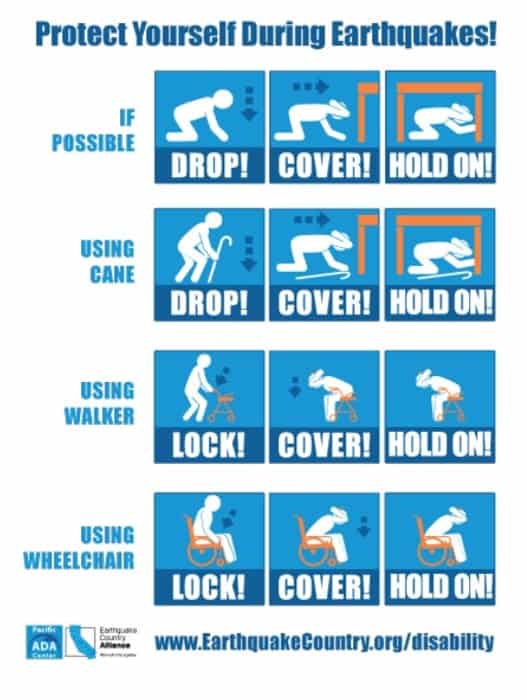
Upcoming – the week of the Great Shakeout (shakeout.org/Oregon/) – October 17-23, with the actual Shakeout on 10/21/21, at 10:21 a.m. We expect everyone to luxuriate in the expanded significance of the whole week, but to focus down on the core event – The Great ShakeOut is an international promotion of earthquake awareness and safety. Any number can (and do) play.
Here are the rules: pay attention because we are in the area of the Cascadia Subduction Zone, which is thought to be ripe for a Great or Very Great Earthquake just about any old time. So, we are going to simulate a serious earthquake beginning at 10:21 and lasting for 4 minutes or so (this is not one of your quick-and-dirty California quakes). You are supposed to take the appropriate action for your location and condition at the time.
First, if you are lucky and attentive, you feel a very noticeable but not devastating shaking. That is your friend the p-wave arriving to let you know that in not more than a minute, the big bad s-wave will arrive and shake the crap out of everything.
Whatever you feel first, ACT! Inside, DROP, COVER, AND HOLD. Anywhere, get away from things likely to fall on you, such as tall furniture, overpasses, power lines, breaking windows, etc. If you’re not sure of what to do or how to do it – well, that’s why we have these days and weeks. Find out.
The following linked references are available on both the myRVM Emergency Preparedness page, and on The Complement/Prepare. Both sites have other information as well.
Recommended Earthquake Safety Actions What to do when it hits.
Earthquake Preparedness Guide — Disabilities Not limited to people with disabilities – preparation advice is good for everyone.
Book Review – The Phone Booth at the Edge of the World
 by Bonnie Tollefson
by Bonnie Tollefson
Book Review – The Phone Booth at the Edge of the World, Laura Imai Messina, The Overlook Press, 2021
A few months ago a fellow resident said to me with a subtle curl of the lip and a wrinkle to the nose, “Eww, you read series fiction.” Yes I do. I enjoy the continuing story of the characters and reading books that feel comfortable. Sometimes the characters develop and occasionally the author does. Series can be found in almost every genre of fiction, so it is not as tho I read only mysteries. However, in recognition of her tastes, this quarter I went to the RVM library to find a book to review that was not part of a series or by an author known for series work, and I found a gem. The Phone Booth at the Edge of the World by Laura Imai Messina is a novel set in Japan, written in Italian, translated into English. The author is Italian, born and raised in Rome, who went to Japan to improve her Japanese. Fifteen years later she still lives in Japan with a husband, two children and a job teaching Italian.
Yuri, a main character in the book, became the host of a call-in radio show in Tokyo after losing her mother and young daughter in the March 11, 2011 tsunami. She hears one evening about a garden with a phone booth where one can talk to the dead. The Wind Phone helps many people deal with the loss of loved ones. This is a book about grief, a book about hope, and a book about love. It can be a quick read or savored, but it contains something for everyone. The author includes the information on research conducted on how many hugs are required in a day for survival, as well as acknowledging that the truth is “that love is a miracle. Even the second time around, even when it comes to you by mistake.” I won’t include a spoiler about what happens to Yuri, but since hope and love are components of the story you might guess. Near the end of the book “Yuri came to understand that there was always joy somewhere within unhappiness.”
The March 11 tsunami was an actual event just as the Bell Gradia garden and the Wind Phone are real. In the author’s note Laura Imai Messina says “For me the Wind Phone is mainly this: a metaphor that suggests how precious it is to hold on tight to joy as well as pain. That even when we are confronted by the subtractions, the things that life takes from us, we have to open ourselves up to the many additions it can offer too.” An important lesson for us all.
The book can be found at both the RVM library and the Jackson County Public Library.
October Library Display
by Anne Newins
This month’s display will feature fiction and non-fiction books about actors. Why are people interested in actors’ lives? It seems to me that when young, one reason many people are curious about actors is because it gives them vicarious pleasure. Most of us are not simultaneously rich, good-looking, and famous.
However, by the time actors have been in the business long enough to have biographies written about them, our interest in them may have changed because we have aged ourselves. It is hard to believe that a seasoned actors like Audrey Hepburn, Michael Caine, Robin Williams, or Ingrid Bergman would not have had challenges, some sort of artistic insight, or viewpoints different from our own as well as unusual life experiences.
Fictional work about actors gives an author tremendous leeway in terms of character development, usually skewing towards their flaws. After all, who wants to read a novel about a boring, nine to five sort of person? Suspense writers are drawn to actors, including popular authors like Jonathan Kellerman and Michael Connelly.
This month’s display also will include biographies about Michael J. Fox, John Wayne, Ronald Reagan, novels by Nora Roberts, Danielle Steel, Kristin Hannah, Stuart Woods, and many others.
The display table is located near the main entrance of the library.
Emergency Power at Home- Why, What and How
By Joni Johnson
When the power goes out, it is very nice – and could be life-saving – to have a back-up source of electricity. Power supplies can be battery packs that are charged when there is power and used when there isn’t, or they can be battery packs attached to an independent source of electricity, like solar panels or car batteries.
Tom and I were very devil-may-care about getting a generator until the second power outage this year. Because of a need to keep some health machines going and the desire to see in the dark, we started looking into options for power supplies that would work here on campus.
Gas: For reasons of safety, RVM does not allow gas or diesel generators in our homes. If someone needs to be hooked up to electricity during a power outage, their main option is to be moved to the Manor for an electric hook-up to the emergency generator there.
Solar: After simple stored-power battery backups, the next and most viable choice is solar powered energy, and there seem to be a lot of these power supplies on campus. After inquiring, I was contacted by a number of people directly and others gave me names of people with this equipment. The big questions are, what do you want to charge, how heavy do you want the machine to be, and how much do you want to spend? All of the batteries discussed in this article can be charged from your electric socket while you have power, from solar panels, or from a 12v car charger.
| Important – before you buy a power supply, make sure that it will work with the equipment you are interested in using. Voltage – AC or DC? All of these batteries do have both options but some of the less expensive ones might not. The Watts (power requirement) – if it doesn’t tell you, multiply Volts times Amps. Watt-hours of the supply will tell you how long it will power an appliance of specific wattage. For example, most home medical gear (CPAP, oxygen concentrators) will run on 12 volts DC, although you may need some accessories, but air purifiers are AC only, and some power supplies do not have AC output. |
Small Power Supplies –
1. David Drury bought a setup from Amazon with an 80-watt solar panel strip (which he can hang from his back deck), and a 296 watt-hour storage battery. It weighs 6.6 lbs.

In his words, “I can charge all kinds of small electronic appliances — up to laptops — as well as batteries for flashlights etc. The storage battery is very versatile, produces both AC and DC current, and even includes a 12-volt attachment for connecting to car batteries. The important point (or one of them) is that using the solar panel in conjunction with a storage battery provides a lot more flexibility. You can charge things when the sun isn’t shining, and take maximum advantage of the sun when it IS shining — whether or not you’ve got anything that immediately needs charging.
If I had any buyer’s remorse, it would be that I got the 80 watt rather than the 100 watt panel (which is 6 feet long, as opposed to my more convenient 4 ft panel). Likewise, the smallish battery unit which would probably not be enough to run an oxygen concentrator. The next higher battery pack is 504 watt -hours.
His solar panels are connected and can be folded into a briefcase. They can be hung as he does or can be mounted at an angle of 40 degrees with their kickstands for better efficiency.
- Keith Maxfield wanted to buy locally and wanted a machine with the smallest possible footprint and with a collapsible handle so that he could keep it in his RV. He chose a Goal Zero Yeti Lithium 500X Portable Power Station.
He also chose a 4 panel connected 100 watt solar panel by Goal Zero, called the Nomad 100, which can fold up.
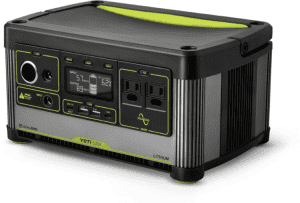
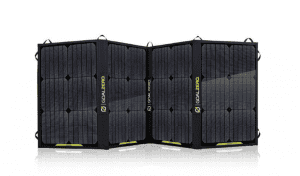
Medium Power Supplies
Tom and I wanted a higher capacity battery, but I needed to be able to carry it. We had to run a battery-powered oxygen concentrator (how many watts?). With a lot of help from Ron Constable, I ended up buying a Jackery 1000 package which included two 100 watt solar panels. The solar panels charge the battery from 0 to 100% in 8 hours in full sun. In our case, Tom’s battery powered oxygen concentrator could last about 10 hours on the battery pack. We have a charger that can charge one of the two concentrator batteries separately, which leaves a lot of room for charging other things like iPhones, iPads and computers. We should also be able to light one lamp, although we did buy a battery-operated lantern. The Jackery 1000 weighs 22 pounds and is fairly easy for me to carry. I bought from Amazon because Home depot’s Jackery was listed as the 880 and in fact only ran 880 watt-hours. When I searched for their 1000, it was significantly more money.
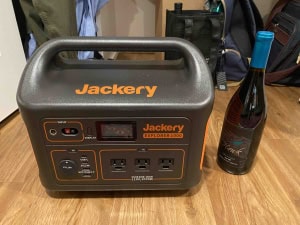
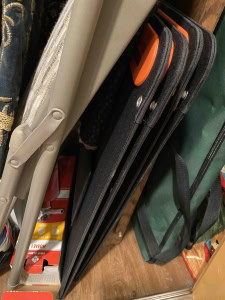
You can see the size of the battery compared to a bottle of wine and how easy it is to store the two panels in a closet. This is what it looks like open.
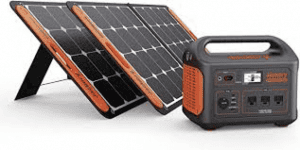
Larger
Bill Anderson has a Jackery 1500 plus the four 100 watt panels included in his package. The Jackery 1500 wasn’t available on Amazon, so he bought it through the Jackery company itself. It weighs 35 pounds. With the 4 solar panels you can recharge the battery in 4 hours of sunlight.
This is what it looks like out on the trail:
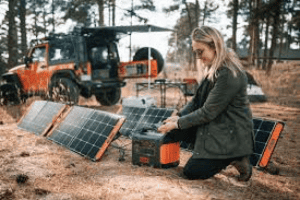
Bill also has a Tesla which can provide electricity, and can have him living the life of Riley for weeks on end without the need for any other power source. With that, he could use his coffee maker, a small refrigerator, an electric frying pan and a toaster.
If you have or want a Tesla, he is the man to talk to about what it can do for you in a power outage.
Really Large
There are other people on campus who have much larger batteries. For example, one person has a Goal Zero Yeti 3000X battery plus two 200 watt solar panels that will cost around $3000 plus the panels, but will run things for a significantly longer period of time. However, it is bigger and heavier (69.78 lb). The Yeti 3000 comes with wheels.
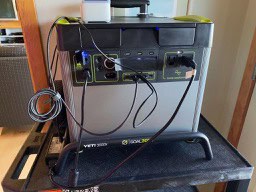
The weather is changing. If we are caught in another power outage or worse yet, an earthquake with indefinite loss of power, what would you do? The bottom line is that there are many choices of solar powered back-up battery systems. The three brands mentioned in this article are well respected. The Jackery and Goal Zero can be bought on-line or in stores such as REI or Home Depot, depending on the brand. Pricing can be vary a lot, so it pays to double check. If you have any questions, the companies seem very accessible. And the owners here on campus have allowed me to post their names as well, and can serve as advisors and references. And there are all sorts of YouTube videos comparing one power source with another. It is worth a look!
Below is a link to a chart showing typical wattage for various appliances and equipment:
https://www.donrowe.com/usage-chart-a/259.htm
for example
cell phone 10
laptop 20-75
iPad 10-20
tv-led 32” 50
tv-42 plasma 240
refrigerator 500-750
CPAP 20-60 W depending on model and accessories
Oxygen concentrators high power, 100-600 W

